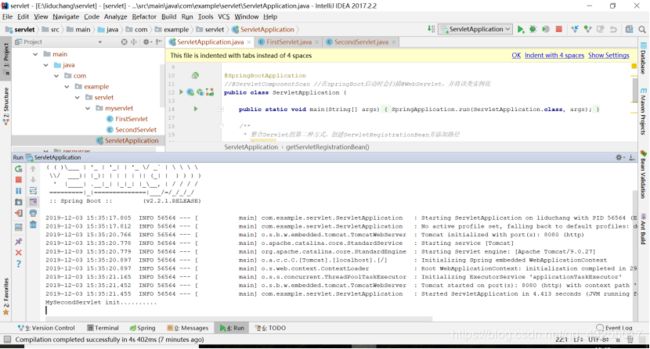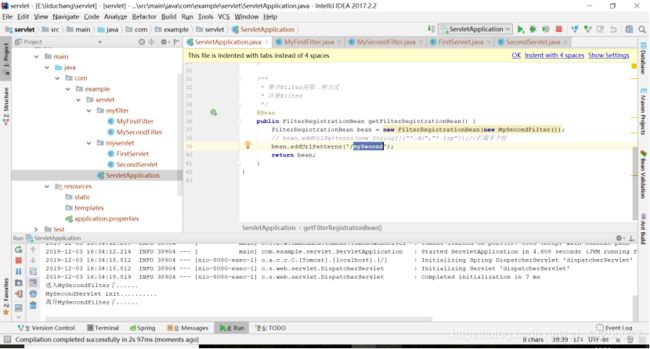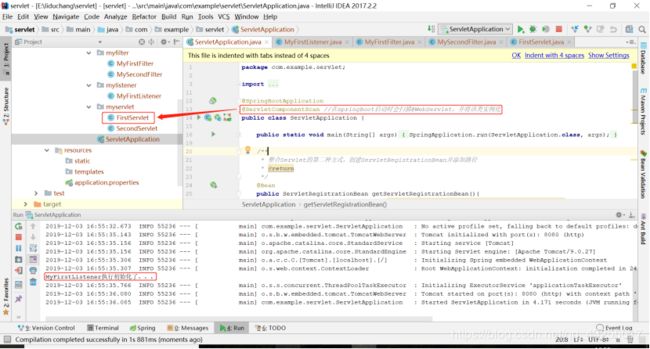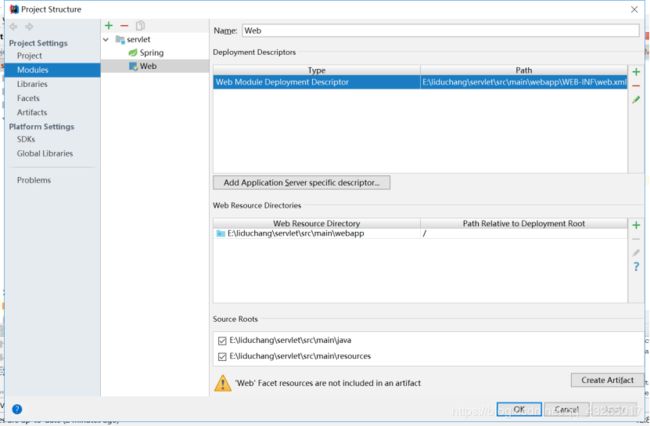idea如何打包发布springboot
1.1.环境准备
window系统,jdk8环境,springboot项目,maven3.5.4环境
1.2.进行打包发布
打开idea编辑器,打开一个写好的demo项目
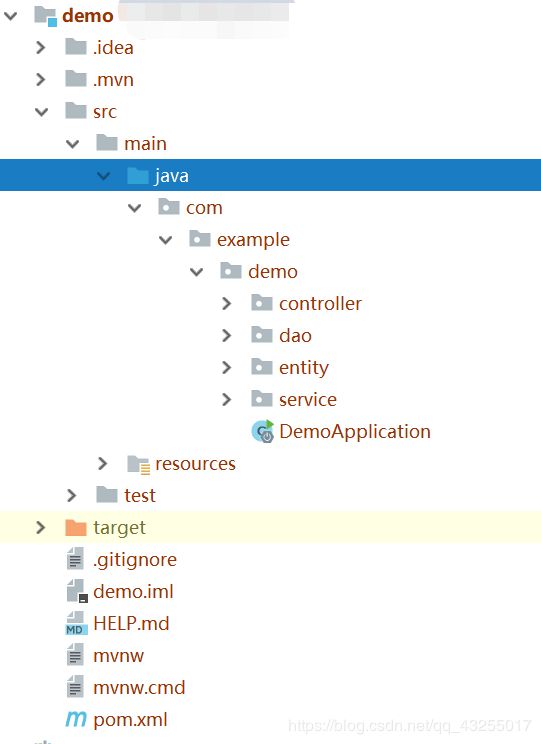 在这里插入图片描述
在这里插入图片描述
然后打开idea编辑器下方的terminal窗口,当你打开这个窗口的时候,所在的位置就是目录的根位置了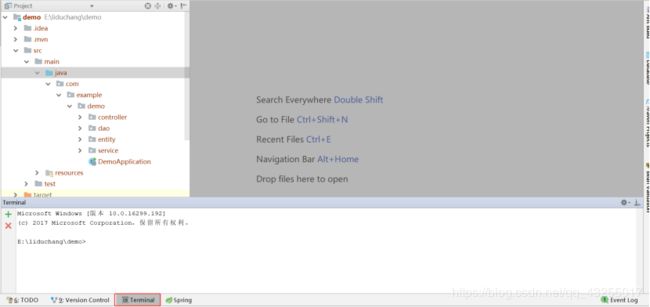 在这里插入图片描述
在这里插入图片描述
输入命令 mvn clean install -Dmaven.test.skip,这条命令就是用maven打成jar包的方式了,然后回车键。 在这里插入图片描述
在这里插入图片描述
当看到BUILD SUCCESS的时候,就说明打包成功,在项目的target目录下就会出现一个jar包,默认的jar包名就是artifactId+version 在这里插入图片描述
在这里插入图片描述
此时再进入到target目录,输入java -jar SpringBoot-Mybatis-0.0.1-SNAPSHOT.jar命令就可以运行jar包了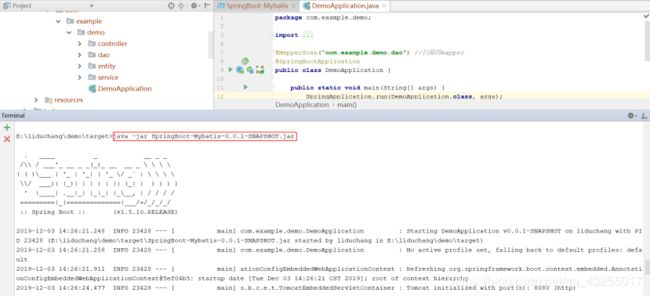 在这里插入图片描述
在这里插入图片描述
当你看到Started DemoApplication in …的时候说明启动成功,就能在本地访问了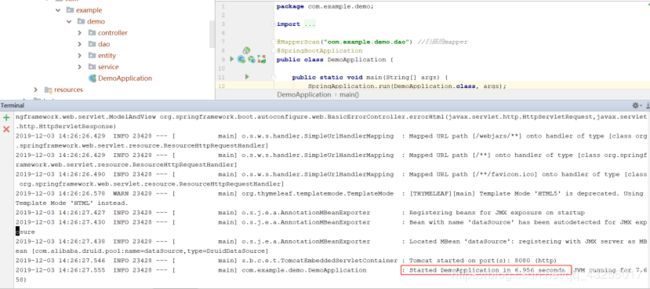 在这里插入图片描述
在这里插入图片描述
结论:这就是SpringBoot项目的在Windows环境发布,linux环境也是一样的,同样要安装jdk和maven环境。这也是springboot的神奇之处,不需要发布到Tomcat下,因为SpringBoot内嵌了web服务器包括Tomcat
特点简介
- 由于传统的ssm、ssh等框架繁琐的配置文件,springboot的出现就是为了简化配置文件
- 内嵌Web服务器包括Tomcat,只需要打成jar包就可以运行项目
- SpringBoot基于全注解式的开发
SpringBoot整合Servlet
3.1.方式一
步骤:
- 写一个类MyFirstServlet继承HttpServlet,并重写doGet方法
- 在类的上面用@WebServlet标识Servlet并指明name和urlPatterns
- 在标识有@SpringBootApplication的主类上加上
@ServletComponentScan
FirstServlet.java
1package com.example.servlet.myservlet;
2
3import javax.servlet.http.HttpServlet;
4import java.io.IOException;
5import javax.servlet.ServletException;
6import javax.servlet.annotation.WebServlet;
7import javax.servlet.http.HttpServletRequest;
8import javax.servlet.http.HttpServletResponse;
9
10/**
11 *SpringBoot整合Servlet方式一
12 *@WebServlet(name="MyFirstServlet",urlPatterns="/myFirst")相当于如下:
13 *
14 *
15 * MyFirstServlet
16 * ah.szxy.servlet.FirstServlet
17 *
18 *
19 * MyFirstServlet
20 * /first
21 *
22 *
23 */
24
25@WebServlet(name="MyFirstServlet",urlPatterns="/myFirst")
26public class FirstServlet extends HttpServlet {
27
28 @Override
29 protected void doGet(HttpServletRequest req, HttpServletResponse resp) throws ServletException, IOException {
30 System.out.println("MyFirstServlet init............");
31 }
32}
ServletApplication.java
1package com.example.servlet;
2
3import org.springframework.boot.SpringApplication;
4import org.springframework.boot.autoconfigure.SpringBootApplication;
5import org.springframework.boot.web.servlet.ServletComponentScan;
6
7@SpringBootApplication
8@ServletComponentScan //在springBoot启动时会扫描@WebServlet,并将该类实例化
9public class ServletApplication {
10
11 public static void main(String[] args) {
12 SpringApplication.run(ServletApplication.class, args);
13 }
14
15}
然后启动项目
最后在浏览器输入localhost:8080/myFirstServlet,页面显示空白,在控制台打印MyFirstServlet init…………
3.2.方式二
步骤:
创建一个类SecondServlet继承HttpServlet,并重写doGet方法。
在@SpringBootApplication标识的主类中加@Bean的一个方法。
SecondServlet.java
1package com.example.servlet.myservlet;
2
3import javax.servlet.ServletException;
4import javax.servlet.http.HttpServlet;
5import javax.servlet.http.HttpServletRequest;
6import javax.servlet.http.HttpServletResponse;
7import java.io.IOException;
8
9/**
10 * 整合Servlet的第二种方式
11 */
12public class SecondServlet extends HttpServlet {
13
14 @Override
15 protected void doGet(HttpServletRequest req, HttpServletResponse resp) throws ServletException, IOException {
16 System.out.println("MySecondServlet init..........");
17 }
18}
ServletApplication.java
1package com.example.servlet;
2
3import com.example.servlet.myservlet.SecondServlet;
4import org.springframework.boot.SpringApplication;
5import org.springframework.boot.autoconfigure.SpringBootApplication;
6import org.springframework.boot.web.servlet.ServletComponentScan;
7import org.springframework.boot.web.servlet.ServletRegistrationBean;
8import org.springframework.context.annotation.Bean;
9
10@SpringBootApplication
11//@ServletComponentScan //在springBoot启动时会扫描@WebServlet,并将该类实例化
12public class ServletApplication {
13
14 public static void main(String[] args) {
15 SpringApplication.run(ServletApplication.class, args);
16 }
17
18
19 /**
20 * 整合Servlet的第二种方式,创建ServletRegistrationBean并添加路径
21 * @return
22 */
23@Bean
24public ServletRegistrationBean getServletRegistrationBean(){
25 ServletRegistrationBean bean = new ServletRegistrationBean(new SecondServlet());
26 bean.addUrlMappings("/mySecond");
27 return bean;
28}
然后启动项目,在浏览器中访问localhost:8080/mySecondServlet,页面也是空白,在控制台就会打印MySecondServlet init……….
项目,结构如图所示
结论:
上面的两种方式推荐使用第一种基于注解的整合
虽然现在几乎用不到servlet了,但是学习SpringBoot整合servlet有助于学习的深入了解,更好的理解框架
4.SpringBoot整合Filter
4.1.方式一
步骤:
创建一个MyFirstFilter类实现Filter接口,并在类上面标注@WebFilter
在@SpringBootApplication的主类上加上@ServletComponentScan注解
MyFirstFilter.java
1package com.example.servlet.myfilter;
2
3import javax.servlet.*;
4import javax.servlet.annotation.WebFilter;
5import java.io.IOException;
6
7/**
8 * 基于@WebFilter注解整合Filter方式一
9 */
10@WebFilter(filterName = "MyFirstFilter",urlPatterns = "/myFirst")
11public class MyFirstFilter implements Filter {
12 @Override
13 public void init(FilterConfig filterConfig) throws ServletException {
14
15 }
16
17 @Override
18 public void doFilter(ServletRequest arg0, ServletResponse arg1, FilterChain arg2) throws IOException, ServletException {
19 System.out.println("进入Filter中了.....");
20 arg2.doFilter(arg0,arg1);
21 System.out.println("离开Filter了.......");
22 }
23
24 @Override
25 public void destroy() {
26
27 }
28}
ServletApplication.java
1package com.example.servlet;
2
3import com.example.servlet.myservlet.SecondServlet;
4import org.springframework.boot.SpringApplication;
5import org.springframework.boot.autoconfigure.SpringBootApplication;
6import org.springframework.boot.web.servlet.ServletComponentScan;
7import org.springframework.boot.web.servlet.ServletRegistrationBean;
8import org.springframework.context.annotation.Bean;
9
10@SpringBootApplication
11@ServletComponentScan //在springBoot启动时会扫描@WebServlet,并将该类实例化
12public class ServletApplication {
13
14 public static void main(String[] args) {
15 SpringApplication.run(ServletApplication.class, args);
16 }
17
18 /**
19 * 整合Servlet的第二种方式,创建ServletRegistrationBean并添加路径
20 * @return
21 */
22 @Bean
23 public ServletRegistrationBean getServletRegistrationBean(){
24 ServletRegistrationBean bean = new ServletRegistrationBean(new SecondServlet());
25 bean.addUrlMappings("/mySecond");
26 return bean;
27 }
28}
4.2.方式二
步骤:
创建一个类MySecondFilter实现Filter接口,重写方法。
在@SpringBootApplication标识的主类中加@Bean的一个方法,将MySecondFilter对象注入容器中。
MySecondFilter.java
1package com.example.servlet.myfilter;
2
3import javax.servlet.*;
4import java.io.IOException;
5
6/**
7 * 整合Filter的第二种方式
8 */
9public class MySecondFilter implements Filter {
10 @Override
11 public void init(FilterConfig filterConfig) throws ServletException {
12
13 }
14
15 @Override
16 public void doFilter(ServletRequest arg0, ServletResponse arg1, FilterChain arg2) throws IOException, ServletException {
17 System.out.println("进入MySecondFilter了......");
18 arg2.doFilter(arg0, arg1);
19 System.out.println("离开MySecondFilter了......");
20 }
21
22 @Override
23 public void destroy() {
24
25 }
26}
ServletApplication.java
1package com.example.servlet;
2
3import com.example.servlet.myfilter.MySecondFilter;
4import com.example.servlet.myservlet.SecondServlet;
5import org.springframework.boot.SpringApplication;
6import org.springframework.boot.autoconfigure.SpringBootApplication;
7import org.springframework.boot.web.servlet.FilterRegistrationBean;
8import org.springframework.boot.web.servlet.ServletComponentScan;
9import org.springframework.boot.web.servlet.ServletRegistrationBean;
10import org.springframework.context.annotation.Bean;
11
12@SpringBootApplication
13//@ServletComponentScan //在springBoot启动时会扫描@WebServlet,并将该类实例化
14public class ServletApplication {
15
16 public static void main(String[] args) {
17 SpringApplication.run(ServletApplication.class, args);
18 }
19
20 /**
21 * 整合Filter的第二种方式
22 * 注册Filter
23 */
24 @Bean
25 public FilterRegistrationBean getFilterRegistrationBean() {
26 FilterRegistrationBean bean = new FilterRegistrationBean(new MySecondFilter());
27 // bean.addUrlPatterns(new String[]{"*.do","*.jsp"});//拦截多个时
28 bean.addUrlPatterns("/mySecond");
29 return bean;
30 }
31}
然后在浏览器访问localhost:8080/mySecond,就可以看到控制台打印如下
5.SpringBoot整合Listener
5.1.方式一
步骤:
创建一个类MyFirstListener实现ServletContextListener接口,重写方法
在该类上加上@WebListener注解
1package com.example.servlet.mylistener;
2
3import javax.servlet.ServletContextEvent;
4import javax.servlet.ServletContextListener;
5import javax.servlet.annotation.WebListener;
6
7/**
8 * springBoot 整合Listener第一种方式
9 * 创建一个Servlet上下文的监听器
10 * @WebListener 自动注册,相当于在web.xml中添加如下代码
11 *
12 *
13 * ah.szxy.listener.FirstListener
14 *
15 */
16@WebListener
17public class MyFirstListener implements ServletContextListener {
18
19 @Override
20 public void contextDestroyed(ServletContextEvent arg0) {
21 // TODO Auto-generated method stub
22 System.out.println("MyFirstListener执行销毁了。。。");
23 }
24
25 @Override
26 public void contextInitialized(ServletContextEvent arg0) {
27 // TODO Auto-generated method stub
28 System.out.println("MyFirstListener执行初始化了。。。");
29 }
30}
执行项目会打印如下,因为用了@ServletComponentScan注解,在项目启动的时候就会扫描包中是否含有servlet,若有就初始化。由于FirstServlet是基于注解初始化的,所以在项目启动的时候,就会执行初始化servlet,被Listener监听到
5.1.方式二
步骤:
创建一个类MySecondListener实现ServletContextListener接口,重写方法
在@SpringBootApplication标识的主类中加@Bean的一个方法,将MySecondListener对象注入容器中。
1package com.example.servlet.mylistener;
2
3import javax.servlet.ServletContextEvent;
4import javax.servlet.ServletContextListener;
5
6/**
7 * 整合Listener的第二种方式
8 */
9public class MySecondListener implements ServletContextListener {
10
11 @Override
12 public void contextDestroyed(ServletContextEvent arg0) {
13 // TODO Auto-generated method stub
14 System.out.println("MySecondListener执行销毁了。。。");
15 }
16
17 @Override
18 public void contextInitialized(ServletContextEvent arg0) {
19 // TODO Auto-generated method stub
20 System.out.println("MySecondListener执行初始化了。。。");
21 }
22
23}
1package com.example.servlet;
2
3import com.example.servlet.myfilter.MySecondFilter;
4import com.example.servlet.mylistener.MySecondListener;
5import com.example.servlet.myservlet.SecondServlet;
6import org.springframework.boot.SpringApplication;
7import org.springframework.boot.autoconfigure.SpringBootApplication;
8import org.springframework.boot.web.servlet.FilterRegistrationBean;
9import org.springframework.boot.web.servlet.ServletComponentScan;
10import org.springframework.boot.web.servlet.ServletListenerRegistrationBean;
11import org.springframework.boot.web.servlet.ServletRegistrationBean;
12import org.springframework.context.annotation.Bean;
13
14@SpringBootApplication
15@ServletComponentScan //在springBoot启动时会扫描@WebServlet,并将该类实例化
16
17public class ServletApplication {
18
19 public static void main(String[] args) {
20 SpringApplication.run(ServletApplication.class, args);
21 }
22
23 /**
24 * 注册listener
25 */
26 @Bean
27 public ServletListenerRegistrationBean getServletListenerRegistrationBean() {
28 ServletListenerRegistrationBean bean = new ServletListenerRegistrationBean(
29 new MySecondListener());
30 return bean;
31 }
32
33}
执行项目,在控制台可以看到输出如下,两个Servlet监听器都执行了
总的项目目录包结构如下:
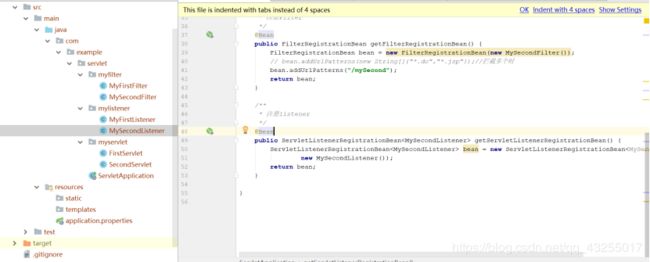 在这里插入图片描述
在这里插入图片描述
6.SpringBoot整合静态资源
6.1.在resource/static路径下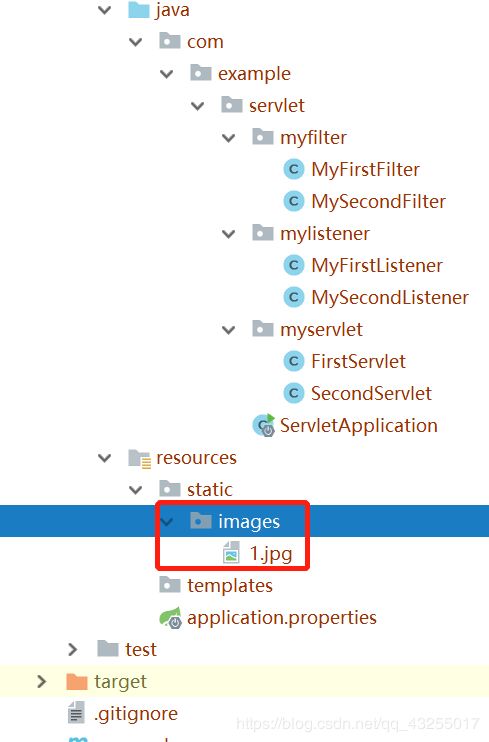 在这里插入图片描述
在这里插入图片描述
然后启动项目,在浏览器访问localhost:8080/images/1.jpg 在这里插入图片描述
在这里插入图片描述
6.2.在webapp目录路径下
6.2.1.idea中为SpringBoot项目添加web
因为SpringBoot的初始化后是没有webapp目录的,需要在idea中手动加入,但不是直接创建,而是配置出来的,下面是SpringBoot项目配置webapp的教程
6.2.2.选中项目然后是ctrl+alt+shift+s,就会弹出如下页面
6.2.3.选中Modules,然后点击+号,如下
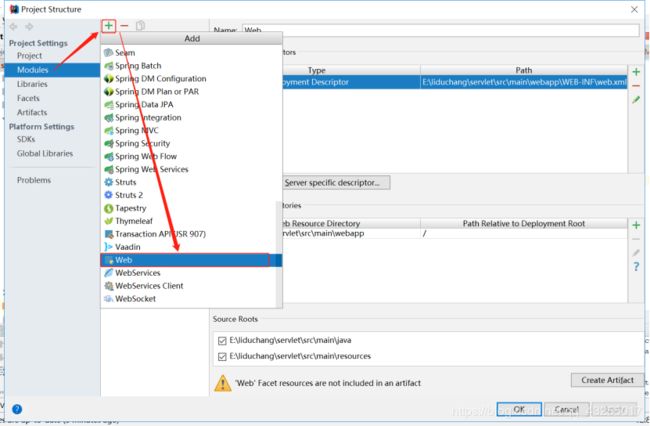 在这里插入图片描述
在这里插入图片描述
配置的目录的路径分别为:
E:\liduchang\servlet\src\main\webapp\WEB-INF\web.xml
E:\liduchang\servlet\src\main\webapp
6.2.4出现如下界面,点击铅笔进行编辑web.xml的路径,然后双击第二处同理编辑webapp的路径
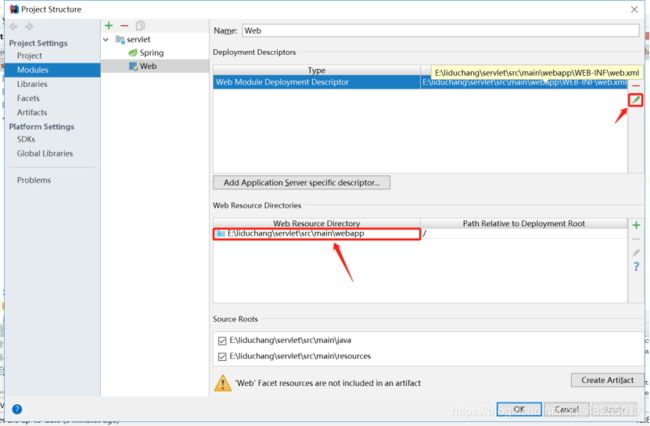 在这里插入图片描述
在这里插入图片描述
6.2.5最后配置出来的目录结构,如下图所示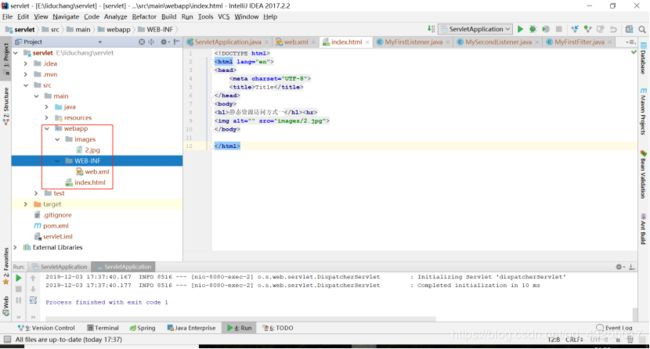 在这里插入图片描述
在这里插入图片描述
6.2.6然后再webapp先新建一个images文件夹,复制一张图片到images文件夹下,名为2.jpg,并再webapp下新建一个index.html内容如下
1
2<html lang="en">
3<head>
4 <meta charset="UTF-8">
5 <title>Titletitle>
6head>
7<body>
8<h1>静态资源访问方式一h1><hr>
9<img alt="" src="images/2.jpg">
10body>
11html>
6.2.7启动项目,然后再浏览器访问localhost:8080,出现如图所示,配置成功
7.SpringBoot文件上传
7.1.文件上传
项目结构图
- 上传到本地磁盘,名字为原文件名
- 上传到本地磁盘,名字为随机名
- 上传到项目webapp文件夹下的images文件夹下
upload.html(文件上传主页)
1
2<html lang="en">
3<head>
4 <meta charset="UTF-8">
5 <title>Titletitle>
6head>
7<body>
8
13<h1>文件上传到本地e盘h1><hr>
14<form action="/uploadToPC" method="post" enctype="multipart/form-data">
15 <input type="file" name="file" ><br>
16 <input type="submit" value="点击上传">
17form>
18
19<h1>文件上传到e盘名字随机h1><hr>
20<form action="/fileUploadToPCWithNameRandom" method="post" enctype="multipart/form-data">
21 <input type="file" name="file" ><br>
22 <input type="submit" value="点击上传">
23form>
24
25<h1>文件上传到本项目h1><hr>
26<form action="/uploadToProject" method="post" enctype="multipart/form-data">
27 <input type="file" name="file" ><br>
28 <input type="submit" value="点击上传">
29form>
30
31body>
32
33html>
FileUploadController.java(文件上传Controller)
1package com.example.servlet.controller;
2
3import com.example.servlet.util.FileUtils;
4import org.springframework.web.bind.annotation.RequestMapping;
5import org.springframework.web.bind.annotation.RestController;
6import org.springframework.web.multipart.MultipartFile;
7
8import javax.servlet.http.HttpSession;
9import java.io.File;
10import java.io.IOException;
11import java.util.HashMap;
12import java.util.Map;
13
14/**
15 * 文件上传Controller
16 */
17@RestController
18public class FileUploadController {
19
20 /**
21 * 测试文件上传到本地e磁盘
22 * @return
23 */
24 @RequestMapping("/uploadToPC")
25 public Map<String,Object> fileUploadToPC(MultipartFile file) throws IOException {
26 // 获取文件名 df8306e403c49fdf701230317dc99d9.jpg
27 System.out.println(file.getOriginalFilename());
28 // 将上传的文件放在e盘下
29 file.transferTo(new File("e:/"+file.getOriginalFilename()));
30 Map<String, Object> map= new HashMap<>();
31 map.put("msg", "上传文件成功");
32 return map;
33 }
34
35 @RequestMapping("/fileUploadToPCWithNameRandom")
36 public Map<String, Object> fileUploadToPCWithNameRandom(MultipartFile file) throws IOException {
37 String name = file.getOriginalFilename();
38 String prefix = FileUtils.getRandomName();
39 String suffix = name.substring(name.lastIndexOf("."));
40 name = prefix+suffix;
41 file.transferTo(new File("e:/"+name));
42 Map<String, Object> map = new HashMap<String, Object>();
43 map.put("msg", "ok");
44 return map;
45 }
46
47 /**
48 * 上传文件到项目的webapp下的images文件夹下
49 * 不过一般文件不会上传到项目下,一般上传到本
50 * 服务器的其它磁盘上,或者上传到专门的服务器
51 * 上,所以这个方法只要了解就好
52 * @param file
53 * @return
54 */
55 @RequestMapping("/uploadToProject")
56 public String uploadToProject(MultipartFile file, HttpSession session){
57 // 通过session获取绝对路径,方法内部加上/WEB-INF/images,
58 // 表示在项目的images目录下,需要创建该文件夹并进行静态资源放行
59 String path= session.getServletContext().getRealPath("/images");
60 System.err.println(path);
61 String fileName= file.getOriginalFilename();
62 File f= new File(path, fileName);
63 try {
64 file.transferTo(f);
65 } catch (IOException e) {
66 e.printStackTrace();
67 }
68 return "ok";
69 }
70}
FileUtils.java(文件随机命名工具类)
1package com.example.servlet.util;
2
3import java.util.Random;
4import java.util.UUID;
5
6/**
7 * 文件名随机生成工具类
8 * @version 1.0
9 */
10public class FileUtils {
11
12 /**
13 * 图片名生成
14 */
15 public static String getRandomName() {
16 //取当前时间的长整形毫秒数
17 long millis = System.currentTimeMillis();
18 Random random = new Random();
19 //获取0-1000不包含1000,的整形
20 int end3 = random.nextInt(1000);
21 //如果不足三位前面补0
22 String str = millis + String.format("%03d", end3);
23 return str;
24 }
25
26 /**
27 * 商品id生成
28 */
29 public static long getRandomId() {
30 //取当前时间的长整形值包含毫秒
31 long millis = System.currentTimeMillis();
32 Random random = new Random();
33 //随机获取0-99不包含99,之间的整形
34 int end2 = random.nextInt(99);
35 //如果不足两位前面补0
36 String str = millis + String.format("%02d", end2);
37 long id = new Long(str);
38 return id;
39 }
40
41}
在配置文件配置文件的上传的配置信息
1application.properties
2#设置单个文件上传大小
3spring.http.multipart.maxFileSize=200MB
4#设置一次请求上传文件的总容量
5spring.http.multipart.maxRequestSize=200MB
最后分享一波java的资源,资源包括java从入门到开发的全套视频,以及java的26个项目,资源比较大,大小大概是290g左右,链接容易失效,获取的方式是关注公众号:非科班的科班,让后回复:java项目即可获得,祝大家学习愉快


